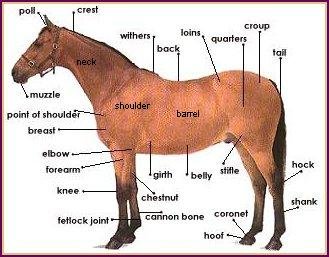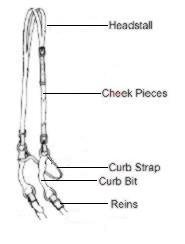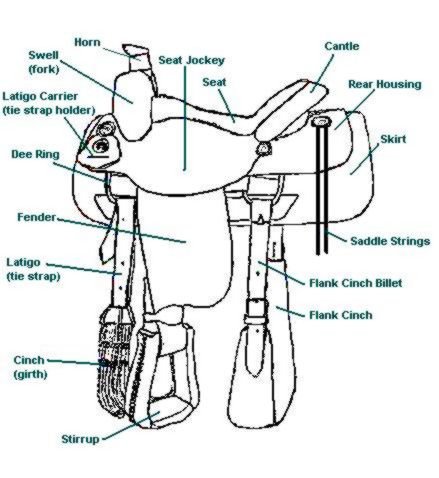Parts of a Horse and Tack
"Know what part is being talked about when you're around experienced horsemen..."
Learn the basic horse anatomy.
An element of good horsemanship is knowning the basic parts of a horse and tack. If you don't want to be a complete "green horn" around seasoned horsemen, then learn the basic anatomy of a horse and know what the different parts of your saddle and bridle are called.
Knowing basic horse anatomy and the names for the different parts of a horse and tack is also important for communicating effectively with your horse's vet or or boarding stable personnel. The parts of the horse and riding gear will often be used when learning to ride or learning to care for your horse -- knowing these names will make it easier to understand what is being taught.
For everyday, you really only need to know the basics of equine anatomy. If want to learn more, though, there is a great number of in-depth instructional material such as books, posters and models available from just about any book store, feed store, or large animal veterinarian that will do a deeper dive into the subject of horse anatomy.
If you just concentrate and stick to the most common and basic part names, you can quickly learn the parts of a horse from ears to hooves and the parts of your saddle from horn to stirrups.
Basic Horse Anatomy

click labels for more detail
Anatomy Terms
| Back | The back starts at the withers and extends to the loins. |
| Barrel | The main body area of the horse, enclosing the rib cage and the major internal organs. |
| Belly | Lower portion of the trunk (barrel) opposite the back. |
| Breast | The front of the horse's body. |
| Cannon | Bone located between the knee and the fetlock, and the hock and the fetlock. |
| Check ligaments | System of ligaments that lock in position allowing a horse to sleep standing up. |
| Chestnut | Horny growth inside and above each knee, and inside and below each hock. |
| Coronet | Or coronary band. It's where the hoof joins the leg -- where the hoof wall is produced. Source of growth and nutrition for the hoof wall and bars. |
| Crest | The upper portion of the neck where the mane grows. |
| Croup | Topline of horse from the top of the tail to the highest point of the hindquarters. |
| Elbow | The joint of the front leg at the point where the belly of the horse meets the leg. |
| Fetlock | Joint formed by the cannon, pastern and sesamoid bones. |
| Forearm | The area of the front leg between the knee and elbow. |
| Frog | Triangular area located towards the back of the underside of the hoof. |
| Gaskin | Part of the hind leg between the hock and the stifle. |
| Girth | The area right behind the elbow of the horse, where the girth of the saddle would go. This area should be where the barrel is at its greatest diameter in a properly-conditioned horse that is not pregnant or obese. |
| Hand | Unit of measurement of the height of a horse, taken from the bottom of the front hoof to top of withers. Four inches = one hand. |
| Hock | Large joint in the hind leg joining the cannon bone and the gaskin. |
| Hoof | The horse's foot. |
| Knee | The large joint in the front legs, above the cannon bone. |
| Loins | The loin or coupling is the short area joining the back to the croup ( rump). |
| Muzzle | The chin, mouth, and nostrils of the horse's face. |
| Neck | The neck connects the head to the shoulders, starting at the poll and ending at the withers. |
| Pastern | Part of the leg between the coronet and the fetlock. |
| Poll | The bony point at the very top of the horse's skull, located slightly behind the ears. |
| Quarters | The large, muscular area of the hind legs, above the stifle and between the barrel and top of the tail. Also called the hindquarters. |
| Sesamoid bones | Small bones attached to the cannon and pastern by ligaments. Located behind the fetlock joint. |
| Shank | The cannon bone on the hind leg. |
| Shoulder | Area below the withers and above the front leg. |
| Stifle | The stifle joint is formed between the large hip bone (femur), which is similar to our thigh bone and the tibia, similar to our shin bone. The stifle joint somewhat resembles a human knee. |
| Tail | Consists of both the living part of the tail (which consists of the coccygeal vertebrae, muscules, and ligaments), as well as the long hairs which grow from the living part. |
| Withers | The top of the shoulders, between the neck and the back. The highest point of the withers is used in measuring the horse's height. |
| appaloosa | color pattern with small spots over the hips or the entire body. may be either white spots on a dark body, dark spots on a white body, or a mixture of both. |
| bay | a red, brown, or yellowish horse with black mane and tail, and usually black limbs. |
| red roan | red with a mixture of white hairs |
| black | black color throughout the coat, limbs, mane and tail. no pattern present other than white markings. |
| blue roan | black or black-brown with a mixture of white hairs. |
| brown | mixture of black and brown in the coat, limbs, mane and tail. |
| buckskin | light tan or brown color. |
| chestnut | varying shades of a yellowish tan color. |
| dun | sandy yellow, redish, or brown usually with darker legs and often a dark stripe down the back, dark mane and tail. |
| grey | black and white hairs with black skin. coat grows lighter with age. |
| palomino | gold-yellow or dark cream color with light colored mane and tail |
| pinto | large patches of black, brown, chestnut, or any other color, and white. |
| strawberry or chestnut roan | chestnut with a mixture of white hairs. |
| white | white hair with a pink skin. |
Parts of a Saddle ( & Bridle )






